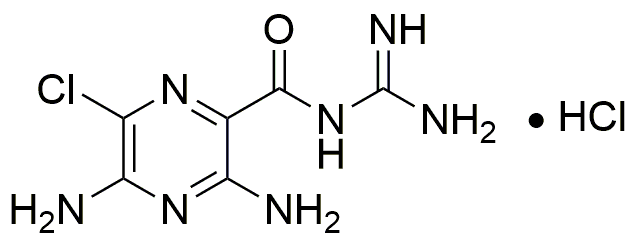Amiloride hydrochloride is widely utilized in research focused on
- Hypertension Management: This compound is primarily used as a potassium-sparing diuretic in the treatment of high blood pressure, helping to reduce the risk of heart disease.
- Heart Failure Treatment: It aids in managing heart failure by preventing excessive potassium loss, which is crucial for maintaining heart function.
- Kidney Function Studies: Researchers often use amiloride hydrochloride to study renal physiology and the mechanisms of sodium transport in the kidneys, providing insights into kidney diseases.
- Diabetes Research: The compound has been investigated for its potential role in improving insulin sensitivity and glucose metabolism, making it relevant in diabetes studies.
- Pharmaceutical Development: Its unique properties make it a valuable candidate in developing new medications targeting electrolyte balance and fluid retention issues.
General Information
Properties
Safety and Regulations
Applications
Amiloride hydrochloride is widely utilized in research focused on
- Hypertension Management: This compound is primarily used as a potassium-sparing diuretic in the treatment of high blood pressure, helping to reduce the risk of heart disease.
- Heart Failure Treatment: It aids in managing heart failure by preventing excessive potassium loss, which is crucial for maintaining heart function.
- Kidney Function Studies: Researchers often use amiloride hydrochloride to study renal physiology and the mechanisms of sodium transport in the kidneys, providing insights into kidney diseases.
- Diabetes Research: The compound has been investigated for its potential role in improving insulin sensitivity and glucose metabolism, making it relevant in diabetes studies.
- Pharmaceutical Development: Its unique properties make it a valuable candidate in developing new medications targeting electrolyte balance and fluid retention issues.
Documents
Safety Data Sheets (SDS)
The SDS provides comprehensive safety information on handling, storage, and disposal of the product.
Product Specification (PS)
The PS provides a comprehensive breakdown of the product’s properties, including chemical composition, physical state, purity, and storage requirements. It also details acceptable quality ranges and the product's intended applications.
Certificates of Analysis (COA)
Search for Certificates of Analysis (COA) by entering the products Lot Number. Lot and Batch Numbers can be found on a product’s label following the words ‘Lot’ or ‘Batch’.
*Catalog Number
*Lot Number
Certificates Of Origin (COO)
This COO confirms the country where the product was manufactured, and also details the materials and components used in it and whether it is derived from natural, synthetic, or other specific sources. This certificate may be required for customs, trade, and regulatory compliance.
*Catalog Number
*Lot Number
Safety Data Sheets (SDS)
The SDS provides comprehensive safety information on handling, storage, and disposal of the product.
DownloadProduct Specification (PS)
The PS provides a comprehensive breakdown of the product’s properties, including chemical composition, physical state, purity, and storage requirements. It also details acceptable quality ranges and the product's intended applications.
DownloadCertificates of Analysis (COA)
Search for Certificates of Analysis (COA) by entering the products Lot Number. Lot and Batch Numbers can be found on a product’s label following the words ‘Lot’ or ‘Batch’.
*Catalog Number
*Lot Number
Certificates Of Origin (COO)
This COO confirms the country where the product was manufactured, and also details the materials and components used in it and whether it is derived from natural, synthetic, or other specific sources. This certificate may be required for customs, trade, and regulatory compliance.

